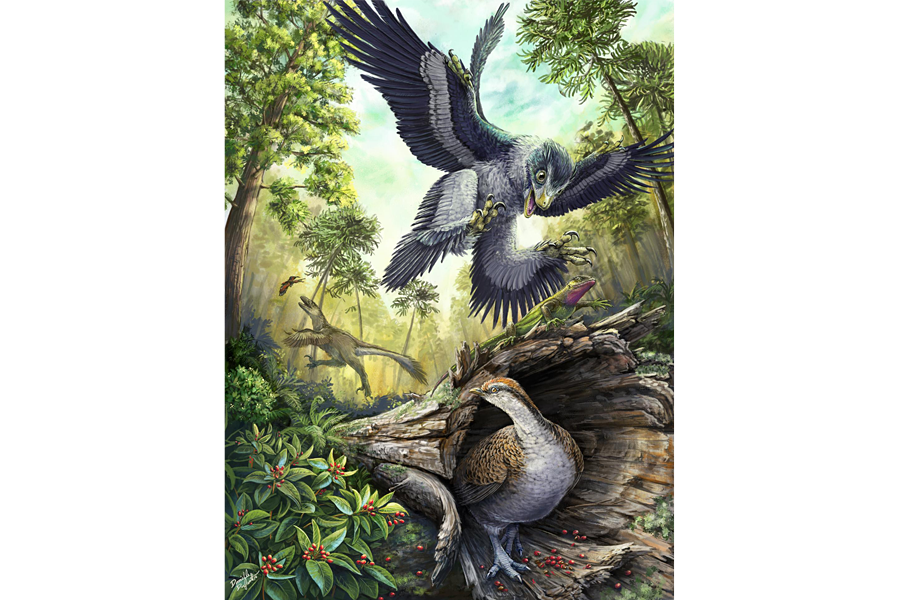Did seeds help birds become the only living dinosaurs?
Loading...
Some 66 million years ago, about 70 percent of Earth's species went extinct. The mass extinction famously ended the age of dinosaurs, but not every dinosaur died out. A class of feathered theropod dinosaurs, better known as birds, live on. How did they survive?
It may have been a seedy affair, according to a team of paleontologists.
Munching on seeds could have kept birds alive through the widespread destruction and extinction of the time, scientists suggest in a paper published Thursday in the journal Current Biology.
"In the catastrophic ecosystem collapse that happened after the asteroid impact that caused the extinction, seeds would have been one of the most abundant food-resources available," study lead author Derek Larson tells The Christian Science Monitor in a phone interview. Plants would have struggled to grow with dramatic climate change, volcanism, a dust-filled atmosphere and other side effects of the asteroid impact. With little food, herbivores, and the carnivores that fed on them, would have had trouble surviving.
But seeds are resilient. Tucked in soil, seeds can be viable for as long as five decades.
However, not everyone could have made use of this resource.
Today's birds are thought to be descended from maniraptoran dinosaurs, a clade of small theropod dinosaurs. Most maniraptorans were thought to have been carnivorous, a diet supported by a mouth full of teeth.
But those same teeth would have made it difficult for these bird-like dinosaurs to live off of seeds after the asteroid hit, the scientists suggest. Instead, it would be the toothless, beaked members of this clade that could nosh their way to survival.
Gaps in the fossil record make it difficult to pinpoint a toothless, birdlike dinosaur.
"We don't know a lot about small theropods during the late Cretaceous," Thomas Williamson, curator of paleontology at the New Mexico Museum of Natural History and Science in Albuquerque, who was not part of this study, tells the Monitor in a phone interview. As small theropod bones are quite fragile, paleontologists are often left with just their more durable teeth.
So Mr. Larson, a PhD candidate at the University of Toronto and assistant curator at the Philip J. Currie Dinosaur Museum in Alberta, and his colleagues worked backward.
The team mapped data about modern bird diets onto the bird family tree. They traced the tree back to its base and found that "the ancestral modern bird was probably able to eat seeds," Larson says.
"I hope in the future that we find a fossil animal that helps corroborate our arguments," Larson says.
Still, David Fastovsky, a paleontologist at the University of Rhode Island who was not part of this study, says he is "very comfortable" with this hypothesis.
"I think that's brilliant," he tells the Monitor. "I don't know why we didn't think of it."
And it's no surprise he likes the hypothesis. Dr. Fastovsky's own work, along with his colleague Peter Sheehan, proposed that the organisms that survived the dinosaur-killing mass extinction were able to tap into a detritus-based food chain that would not have been demolished by the humongous asteroid impact.
While the food chain that was based around photosynthesizing plants would have collapsed because the dust in the atmosphere blocked sunlight, the organic waste that remained could have fed other organisms and supported a different food chain. The seeds could have survived along with that detritus, Fastovsky says.
Seeds might have played a part in this survival story, Larson says, but they were likely not the solution for every animal that lived through that mass extinction.
"We're not saying that this is the only way that anything survived the mass extinction," he says. "For instance, crocodilians survived the mass extinction and we're not proposing that crocodiles and alligators were chomping on seeds. Their teeth are entirely unsuited to that."
Larson's hypothesis arose out of research into another longstanding paleontological debate: whether dinosaurs were struggling or thriving before that asteroid finished them off.
Scientists investigating this question have often looked at the diversity of dinosaurs leading up to 66 million years ago. A paper published Monday suggested that dinosaur diversity had been declining for as long as 50 million years before the asteroid slammed into the Earth and finished the beasts off.
That team of researchers used statistical analysis to examine trends in dinosaur diversity across all species. Larson's team focused in on birdlike dinosaurs and looked directly at their teeth.
The scientists looked at the shape of the teeth to see if the group was changing in response to any ecological stresses before the asteroid hit. "We found that, for this particular group of dinosaurs, there was no decline leading up to the end-Cretaceous," Larson says. "In fact, this group of dinosaurs went extinct very suddenly."
Fastovsky says this adds "another little chunk of data to this equation. They're using another metric to reflect on whether this is really a stressed ecosystem going into the moment of the K-T boundary," the geological moment that marks the extinction of the dinosaurs.
Studying the demise of the dinosaurs and the survival of the birds is like a "natural experiment," says Dr. Williamson. "You can actually see what happens when there's a sudden ecological catastrophe."






